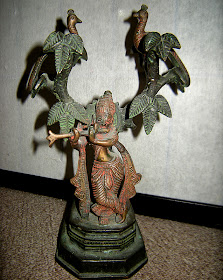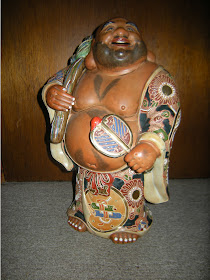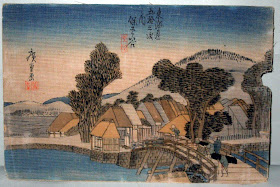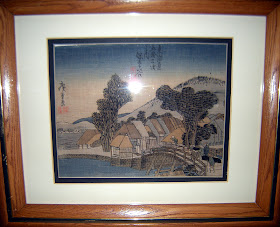During one of my recent treasure hunts looking for Asian art, I found another Yixing Zisha clay teapot, made by Cao Ruiying, marked with a seal on the bottom that reads 曹瑞英制, Cáo ruì yīngzhì, made by Cao Ruiying. There's another mark under the lid with a simple mark for Ruiying, 瑞英.. I'm not sure if Ruiying is one word, or supposed to be two, like Rui Ying.
It's a fairly simple yixing pot, but I like it very much. To date I still haven't been able to find out anything online about the artist, but it's not uncommon for that to happen, especially when dealing with unknown or not famous artists. I'm not sure of the age of this pot, but it does not appear that old to me, so my best guess is mid to late 20th century as a possible range which is fine with me since Yixing Zisha teapots are great little teapots for brewing teas, and now I have another Yixing maker's mark to add to my list of Yixing Artist's Seal Marks.
I have another small Yixing Zisha teapot I want to post and share here, however, have not had the calligraphy on it nor the mark translated, so have been holding off until the artist is identified, so when that's done I will share that one here as well, and hope to acquire more Yixing teapots for my collection.
Notes on my personal collection of Asian art & antiques.. 亚洲艺术与古董收藏黎塔藇呤凯利
▼
November 10, 2014
September 30, 2014
Yamahiro Pottery Heike Monogatari Ginger Jar by Hayashi Gyokko
 I picked up this Japanese porcelain ginger jar on eBay awhile back and have been intrigued by it ever since.
I picked up this Japanese porcelain ginger jar on eBay awhile back and have been intrigued by it ever since.For me, one of the most fascinating parts of collecting Asian art and antiques is the enormous amount of history learned though researching individual pieces and this ginger jar is no exception.
The jar depicts a Japanese Samurai mounted on a horse and has an inscription with two rakkan seals.
I am told by my friend Seth Lim of Singapore that the inscription is in reference to The Heike monogatari tale of a competition between Japanese Samurai commander Sasaki Takatsuna (佐々木 高綱, 1160 – December 8, 1214) riding a white horse and Samurai warrior Kajiwara Kagesue (梶原 景季, 1162 - February 6, 1200) on a black horse, racing to be the first to engage in battle at the 1184 battle of Uji (宇治川の戦). Takatsuna was first (高綱先陣).
I believe that the Samurai on the jar is Kajiwara Kagesue since the horse on the jar is dark, even though not entirely black, but more brownish.
Next to the inscription is a signature and
two rakkan seals that read 林 玉光 , Made by Hayashi Gyokko who was the artist that painted the scene on the vase. A decal is applied to the vase and is then glazed over with a clear glaze.
The bottom is maker marked with the Kaku seal of Yamahiro Mfg Co. Seto, Aichi, Japan.
The seal reads 山弘陶苑, Yamahiro Toen, which translates as Yamahiro Pottery Studio.(or center).
The pseudo-quasi "expert" Gotheborg erroneously claims the mark says "Sanko Toen" which is not even remotely close. It's flat out false.
The only thing they got right on this mark is Toen, but I suppose that's the be expected considering the source.
Fact is, the term Sanko is used when counting small objects and literally means 3 pieces, so how some pretentious fool came up with the BS about "porcelain in the big mountain" is beyond me. Second, there is no character for any form of KO anywhere in the seal, so even though 山 sometimes does mean San, it's usually at the END in Japanese porcelain marks as "zan", and when it's the first character, 山 is usually always YAMA. If the seal said Sanko Toen, it would be written as 三 個陶苑 and would translate as 3 pieces pottery center. It's understandable for someone to misread 山 as San, since several Japanese language characters have more than one meaning, and is an easy mistake to make, but there's no way possible to mistake 弘 as Ko. It's not even remotely close...
Seals translated by Hung-Yueh Hsu, Taipai, Taiwan.
September 27, 2014
Zhou Guizhen Yixing Teapot, Cups & Original Box - 周桂珍 宜兴 茶壶
Zhou Guizhen Yixing Teapot, Cups & Original Box - 周桂珍 宜兴 茶壶
Complete vintage Yixing tea set in its original box, but it's not just any ordinary Yixing Zisha purple clay tea set, it's a Yixing tea set made by famous master potter & Chinese living national treasure, Zhou Giuzhen. (Born in 1943).
Yixing clay teapots , also called "Zisha", or Purple clay are made from Yixing clay. This traditional style of tea pot originated in China, dating back to the 15th century, and are made from clay produced near Yixing in the eastern Chinese province of Jiangsu.
The Yixing tea pot is marked with a signature chop seal on the bottom that reads 周桂珍 制 , Zhōuguìzhēn zhì, Made by Zhou Guizhen. Next to the chop seal are two additional seals, one that reads Zhou 周, another that reads Giuzhen 桂珍. Each of the handles is also signed Zhou 周. The label on the box reads 周桂珍 制, Made by Zhou Giuzhen with a chop seal beneath it that reads China Yixing, 中國 宜興.
For Sale. $25,000 usd/obo + shipping & insurance
Complete vintage Yixing tea set in its original box, but it's not just any ordinary Yixing Zisha purple clay tea set, it's a Yixing tea set made by famous master potter & Chinese living national treasure, Zhou Giuzhen. (Born in 1943).
Yixing clay teapots , also called "Zisha", or Purple clay are made from Yixing clay. This traditional style of tea pot originated in China, dating back to the 15th century, and are made from clay produced near Yixing in the eastern Chinese province of Jiangsu.
The Yixing tea pot is marked with a signature chop seal on the bottom that reads 周桂珍 制 , Zhōuguìzhēn zhì, Made by Zhou Guizhen. Next to the chop seal are two additional seals, one that reads Zhou 周, another that reads Giuzhen 桂珍. Each of the handles is also signed Zhou 周. The label on the box reads 周桂珍 制, Made by Zhou Giuzhen with a chop seal beneath it that reads China Yixing, 中國 宜興.
Zhou Giuzhen was born in 1943 in Yixing, Dingshan, Jiangsu province, China. She started her apprenticeship in crafting Yixing pottery in 1958 at Yíxing Zisha Factory Number 1 under the tutelage of renowned masters Yin Chun Wang and Gu Jingzhou
In 1989 she was awarded the "Ceramic Art and Design" award by the China Arts & Craft Association. During that same year one of her Yixing teapots was added to the Nanjing Museum collection. Ms Zhou Giuzhen has earned several awards and recognitions for her work over the last several decades and has been designated a living national treasure by the Chinese government.
Several of her works are in Museum collections in various Chinese museums. Zhou Giuzhen's Yixing Teapots are highly sought after by collectors all over the world, often commanding astronomical prices at auction.
Here's a video of Master Zhou Giuzhen hand crafting a Yixing tea pot.
.JPG)
.JPG)
.JPG)
.JPG)

In 1989 she was awarded the "Ceramic Art and Design" award by the China Arts & Craft Association. During that same year one of her Yixing teapots was added to the Nanjing Museum collection. Ms Zhou Giuzhen has earned several awards and recognitions for her work over the last several decades and has been designated a living national treasure by the Chinese government.
Several of her works are in Museum collections in various Chinese museums. Zhou Giuzhen's Yixing Teapots are highly sought after by collectors all over the world, often commanding astronomical prices at auction.
Here's a video of Master Zhou Giuzhen hand crafting a Yixing tea pot.
.JPG)
.JPG)
.JPG)
.JPG)

For Sale. $25,000 usd/obo + shipping & insurance
September 21, 2014
Original Chinese Shan Shui Paintings by Chen Hongchou 陳 洪疇 山水
Not too long ago I bought these original Chinese Shan Shui (Mountain-Water 山水) landscape paintings by Chen Hongchou, ( 陳 洪疇 ) on eBay. They're fairly recent I believe, and I also believe that Chen Hongchou is most likely a Chinese American, or at the very least, living in a Western country, because the works are painted on Western paper, not a traditional Asian paper used in traditional Chinese painting. They're painted on Watercolor paper, not a rice paper like Xuan or Kozo, etc. The sharp, bright colors also tell me that this is a newer painting, most likely painted within the last 10 years.
I couldn't find any information online about the artist Chen Hongchou, because another painter, from Ming Dynasty period China, shares a similar name, Chen Hongshou, and when I do Google searches, anything relevant to Chinese paintings by Chen Hongchou ends up showing results for Chinese paintings by Chen Hongshou.
This Chinese shan shui landscape painting is signed 洪疇, Hongchou, and is stamped with his chop seal, 陳洪疇, Chen Hongchou. The Chinese calligraphy reads: 影落明湖青黛山. ( Green mountain shadow reflected on the lake )
On this shan shui landscape painting, the Chinese calligraphy reads:登高壯觀天地間 大江茫茫去不還 and is signed Hongchou, 洪疇 above his chop seal 陳 洪疇 , Chen Hongchou. In English, it translates as Climb the high can see spectacular scenery. Vast big river flow away never come back.
Much gratitude and thanks for my friend Hung-Yueh Hsu for his invaluable assistance in translating the calligraphy & seals for me.
I couldn't find any information online about the artist Chen Hongchou, because another painter, from Ming Dynasty period China, shares a similar name, Chen Hongshou, and when I do Google searches, anything relevant to Chinese paintings by Chen Hongchou ends up showing results for Chinese paintings by Chen Hongshou.
This Chinese shan shui landscape painting is signed 洪疇, Hongchou, and is stamped with his chop seal, 陳洪疇, Chen Hongchou. The Chinese calligraphy reads: 影落明湖青黛山. ( Green mountain shadow reflected on the lake )
On this shan shui landscape painting, the Chinese calligraphy reads:登高壯觀天地間 大江茫茫去不還 and is signed Hongchou, 洪疇 above his chop seal 陳 洪疇 , Chen Hongchou. In English, it translates as Climb the high can see spectacular scenery. Vast big river flow away never come back.
Much gratitude and thanks for my friend Hung-Yueh Hsu for his invaluable assistance in translating the calligraphy & seals for me.
September 17, 2014
TT Hand Paint Made in Japan Takito Satsuma Style Moriage Geisha Figurines
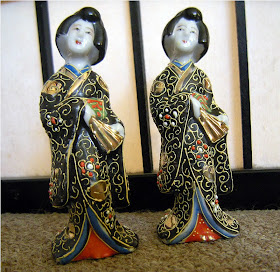 Last week I won an auction bid on a mixed lot lot of 14 pieces, among them were this pair of Satsuma style moriage geisha figurines, made by Takito.
Last week I won an auction bid on a mixed lot lot of 14 pieces, among them were this pair of Satsuma style moriage geisha figurines, made by Takito.They're marked with the TT double diamond logo & Hand Paint, Made in Japan and are circa somewhere between 1921 - 1941. ( Taisho period to Early Showa period.)
Takito was in business from 1880 to 1948. Products prior to 1921 were marked Nippon. There were no exports out of Japan from December, 1941 to 1945 due to sanctions during WWII. From 1945 to 1948 Takito company products were marked "Made in Occupied Japan"
.jpg)
.jpg)
.jpg)
This particular pair are pre war era, circa 1920s- early1940s
For Sale $100 usd/obo + shipping & insurance
September 14, 2014
Fuku Marked Imari - Arita Yaki Sometsuke Sansui Kanshi Chuzara - 福 伊万里焼/有田焼 染付 山水 監視 中皿
Fuku marked Japanese Imari / Arita sometsuke sansui kanshi chuzara.
This small blue & white (sometsuke 染付 ) Imari ( 伊万 ) plate (chuzara 中皿 ) is painted with a scene of a man rowing upstream in a river towards the mountains. (sansui 山水 ) It is octagon shaped and has a short poem ( kanshi 監視 ) that reads 述(?)溪 嵐山 清流遊筏. Upstream ? Arashiyama, rafting on a clear stream? The back of the plate is decorated in an underglaze blue, cash and comb pattern and is marked Fuku ( 福 ) the Japanese word for "good fortune".
Arashiyama, ( 嵐山 Storm Mountain) is Mount Arashi, across from the Ōi River on the Western outskirts of Kyoto, Japan.
This small blue & white (sometsuke 染付 ) Imari ( 伊万 ) plate (chuzara 中皿 ) is painted with a scene of a man rowing upstream in a river towards the mountains. (sansui 山水 ) It is octagon shaped and has a short poem ( kanshi 監視 ) that reads 述(?)溪 嵐山 清流遊筏. Upstream ? Arashiyama, rafting on a clear stream? The back of the plate is decorated in an underglaze blue, cash and comb pattern and is marked Fuku ( 福 ) the Japanese word for "good fortune".
Arashiyama, ( 嵐山 Storm Mountain) is Mount Arashi, across from the Ōi River on the Western outskirts of Kyoto, Japan.
I'm not certain of this Imari plate's age, but am guessing that it's Meiji period, although it could be earlier, or later. I'll have to research this further so I can make an accurate determination.
Inscription translated by my friend Hung-Yueh Hsu, Taipei, Taiwan.
Kutani Meizan Koro Tomobako 九谷明山香炉 供箱
For the longest time, I wished that the Japanese porcelain pieces in my collection had their original wood box, called Tomobako, or Kyō-bako in Japanese, and although there are many Japanese porcelain pieces on the market in their original box, I decided to look around and see if I could find any Tomobako for sale.
I found this one on an online auction site, and although it was part of a lot of mixed boxes of different kinds, I was only interested in the Japanese Tomobako, so I contacted the seller and asked if he would sell it to me without the others in the lot. Fortunately for me he said yes.
It is seal marked Kutani Meizan, 九谷明山. The small seal in the upper right reads Kutaniyaki, 九谷焼. The calligraphy in the center reads Koro, 香炉, the Japanese word for incense burner. The calligraphy above the seal reads 明山造, Meizan zo. (Made by Meizan).
Now all I need is to find a Kutani Meizan Koro to go in this box, as well as more Tomobako and Japanese porcelain with their original Tomobako. :)
Thank you to my friend and neighbor Miho Takahashi for the calligraphy translation.
I found this one on an online auction site, and although it was part of a lot of mixed boxes of different kinds, I was only interested in the Japanese Tomobako, so I contacted the seller and asked if he would sell it to me without the others in the lot. Fortunately for me he said yes.
It is seal marked Kutani Meizan, 九谷明山. The small seal in the upper right reads Kutaniyaki, 九谷焼. The calligraphy in the center reads Koro, 香炉, the Japanese word for incense burner. The calligraphy above the seal reads 明山造, Meizan zo. (Made by Meizan).
Now all I need is to find a Kutani Meizan Koro to go in this box, as well as more Tomobako and Japanese porcelain with their original Tomobako. :)
September 13, 2014
Unidentified Azuchi-Momoyama Period Japanese Kano School Painting
I recently found an original Japanese Kano School painting in an antiques shop, and although the painting is unsigned and lacks any text or seals, I believe it to be from Azuchi-Momoyama Period , although it could very well be early Edo period, or even Meiji for that matter, since it's difficult to attribute this work to any particular Kano school painter since it is unsigned.
The painting was re-framed sometime between 1943 & 1955. I know this because the framer's label marked "Boston Book and Art Shop, 12? Newbury Street, Boston 16, Mass", :on the back has a 2 digit US zipcode, 16, which was only used between 1943 to 1963, however, according to a photograph of Boston Book & Art Shop found in the MIT Libraries collection, they were on Boylston Street in 1955.. I also know that this painting was also framed prior to this framing job, because the work contains at least 2 different matte burns of different sizes, the other being smaller than the matte which was in this particular frame.
Unfortunately it has also been mounted on a thick card stock and not in a traditional Japanese way. It is my belief that the work may have originally been part of a multi-panel work and that the signature was on a different panel, or that it was originally a larger work, mounted on a scroll and that the scroll was possibly in very poor condition with damage and that someone trimmed the work, mounted and framed the remaining undamaged portion, and that the signature was possibly lost, destroyed or trimmed off prior to framing, however, I believer the former is more likely the case given that the rocks and tree to the left would most likely continue both upward and to the left as part of a more complete scene.
I have been researching Kano school paintings extensively attempting to attribute this work to a specific artist, and it's enough to make my brain explode, therefore I temporarily give up, for now, because what I really need, is the advice and opinion of an expert on Japanese Kano School paintings.
.jpg)
.jpg)
.jpg)
.jpg)
Naturally I removed the painting from the frame, which I always do when acquiring art pieces. If there's one thing I have a pet peeve about, it's mattes, cardboard backings and non-traditional mounting methods, so I always remove paintings from whatever frame they're in, and if possible, hope to remove the work from its existing mounting and have appropriate conservation methods applied by a professional conservator.
If you have any ideas or suggestions on who the artist is of this Japanese Kano School painting, please comment. Thank you
pp20 est1000+
The painting was re-framed sometime between 1943 & 1955. I know this because the framer's label marked "Boston Book and Art Shop, 12? Newbury Street, Boston 16, Mass", :on the back has a 2 digit US zipcode, 16, which was only used between 1943 to 1963, however, according to a photograph of Boston Book & Art Shop found in the MIT Libraries collection, they were on Boylston Street in 1955.. I also know that this painting was also framed prior to this framing job, because the work contains at least 2 different matte burns of different sizes, the other being smaller than the matte which was in this particular frame.
Unfortunately it has also been mounted on a thick card stock and not in a traditional Japanese way. It is my belief that the work may have originally been part of a multi-panel work and that the signature was on a different panel, or that it was originally a larger work, mounted on a scroll and that the scroll was possibly in very poor condition with damage and that someone trimmed the work, mounted and framed the remaining undamaged portion, and that the signature was possibly lost, destroyed or trimmed off prior to framing, however, I believer the former is more likely the case given that the rocks and tree to the left would most likely continue both upward and to the left as part of a more complete scene.
I have been researching Kano school paintings extensively attempting to attribute this work to a specific artist, and it's enough to make my brain explode, therefore I temporarily give up, for now, because what I really need, is the advice and opinion of an expert on Japanese Kano School paintings.
This Japanese painting, painted in Kano-ha style, measures approximately 13¼" wide x 10⅞", is unevenly trimmed, & depicts a woman playing a stringed musical instrument to a mother and female child sitting beneath a pine tree. The stringed instrument rests across the woman's lap.
.jpg)
.jpg)
.jpg)
.jpg)
Naturally I removed the painting from the frame, which I always do when acquiring art pieces. If there's one thing I have a pet peeve about, it's mattes, cardboard backings and non-traditional mounting methods, so I always remove paintings from whatever frame they're in, and if possible, hope to remove the work from its existing mounting and have appropriate conservation methods applied by a professional conservator.
If you have any ideas or suggestions on who the artist is of this Japanese Kano School painting, please comment. Thank you
pp20 est1000+
September 12, 2014
Chinese Hand Painted Marble Tile 盧溝曉月 Lu Gou Xiao Yue
I'm not sure when this was painted, nor do I know who the artist is, but the painting itself is rather crude and of very low artistic quality, yet I still wanted it enough to buy it on ePay, and since it was just delivered today, I decided to post it here.
It's a hand painted marble tile of the Lu Guo Bridge near Beijing. The inscription reads 盧溝曉月, Lú gōu xiǎo yuè, translated to english as "In the Lugou bridge to appreciate the moon". Thank you to my friend Hung-Yueh Hsu in Taiwan for the translation.
The tile is wrapped in a handmade cloth frame and is only 3 1/4" x 4 1/2"
It definitely appears to be a one of a kind hand made work.
It's a hand painted marble tile of the Lu Guo Bridge near Beijing. The inscription reads 盧溝曉月, Lú gōu xiǎo yuè, translated to english as "In the Lugou bridge to appreciate the moon". Thank you to my friend Hung-Yueh Hsu in Taiwan for the translation.
The tile is wrapped in a handmade cloth frame and is only 3 1/4" x 4 1/2"
It definitely appears to be a one of a kind hand made work.
September 9, 2014
Antique Krisha Sculpture Statue
Sometimes I buy things out of pure impulse, as if I'm compelled to, because I simply can't resist. Such is the case with this antique bronze Krisha statue that I found in a local antiques store awhile back, and although at the time I had no clue whatsoever that it was Krishna, I did immediately recognize it as something from India because of the peacocks perched in the tree, and it appealed to me as something different and unique for my collection, so I bought it mistakenly thinking that it's possibly a Buddhist figure, because at the time I was still learning about all the different various deities and personas in Buddhism.
September 3, 2014
Large Japanese Porcelain Kutani Moriage Hotei Statue 九谷布袋
It seems I am once again blessed with good fortune.
I never know what I'll find when I'm out hunting for Asian art and antiques. Call me obsessed, but I have this compulsion to do so as often as possible whenever I'm financially able to, even if it means scouring the shelves of a thrift store hoping to bring home something unique for super dirt cheap.
So today was the first day of school and with my daughter gone for the day, I decided to hit up a couple of shops I frequently visit, and, well, I wasn't counting on making any large dollar amount purchases and I hope I'm not going to regret doing so later when I'm sending out checks for my monthly household bills, etc since it appears I have exhausted my available spending funds for the next two weeks.
One of the shops I stopped at is an antiques store which I visit very often, at least once a month. Today, as I entered the store, the owner, a 90+ year old woman, was just about to step outside. We began talking, as we customarily do, and she started talking about this large stained glass window that was next to her leaning against the wall by the front door, and that she wants to move it to the other side of the store on the window sill. I offered to move it for her, and as a result, it appears maybe I got a bargain price on this large Japanese Kutani Hotei statue.
Hotei ( 布袋 ) is one of the Japanese Shichifukujin 七福神 , The Seven Gods of Fortune, or in Western terms, Seven Lucky Gods. Hotei is the fat and happy god of contentment, happiness, abundance and good health, also known as Budai or Pu-Tai in Chinese mythology and/or folklore, etc. In Western culture, he is referred to as the Laughing Buddha even though he is not Buddha, albeit some Buddhist sects consider him to be an incarnation of Maitreya or Miroku Nyorai.
The base of the statue has an incised Kutani mark, 九谷, and is intricately decorated in a Satsuma moriage style. He is approximately 14" tall and weighs at least 8 to 10 pounds I think.
After I finished moving the large stained glass window, there on the shelf in front of me was a large Satsuma temple vase, which I eagerly and excitedly oohed and aahed over until I saw the "Made in Japan" mark on the bottom. Sure I liked the vase, but I felt perhaps it was not that old, so I decided perhaps I should not fork over $50 for it, and that's when I turned around and saw what looked like a Satsuma Hotei, yet when I picked it up for a closer look, realized that it was not Satsuma at all, but Satsuma style, because the clay was not an earthenware, nor was there the tell tale Satsuma crackled glaze. At the time I couldn't even see the marking, because I didn't have my magnifying glass and my eyes are poor these days. The owner of the shop also has bad eyes, so when she asked me if I could read or see the mark, my answer was "I think I see Made in.. it probably says Made in Japan", and it wasn't until I got home that I saw that it's actually a Kutani mark, 九谷.
I put the Hotei statue down and browsed around her shop, picking up a 6 1/2" Satsuma vase with a Samurai decorated in moriage, and a small Chinese saucer with the Shou symbol for longevity, 壽. After I placed them onto the counter, I went back to examine Hotei, hoping it was within my budget and I asked the owner, "how much is he?" Her answer was "since you helped me, you tell me what it's worth to you". I was hesitant, because I didn't want to sound cheap, although I'm certain she knows all too well that I'm always looking for bargains as I've haggled with her 90% of the time I have ever made a purchase from her, but also, at the same time, I knew I only had $40 in my pocket, so, without thinking of the other two items I also wanted, I said "I only have $40 in my pocket" to which she said "sold.. I'll give it to you for that price" which pleased me very much even though I knew I would be broke until I get paid again.
When I got to the counter to pay, that's when I realized I didn't have enough to pay for the other two items, however, she trusted that I would come back and pay, so allowed me to take them home on the promise that I would return, which of course I will, because I have known this woman for over a year now and have been in her store at least several dozen times, as well as see her around town in other shops, etc.. even at a local auctioneer's hall, so, and besides, she also knows my name and where I live, so yes, of course she trusts me.
I immediately began Googling around trying to determine how old this Kutani Hotei is, as well as its potential value, and I'm coming up with various possibilities for its age, from late Meiji to early Taisho, even early Showa, so my research is incomplete and its age remains uncertain at this time.
As for value, well, that's a real crap shoot, because all I have to go by are eBay listings, and, well, sorry to say, but the majority of sellers on eBay don't know their freaking ass from their elbow, never mind the age and values of Japanese porcelain and antiques, etc. They pretty much pull numbers out of thin air, like one particular delusional fool from Seattle who thinks her Kutani Hotei is worth $950 + shipping. I say good luck with that as I laugh at how absurd her asking price is. I have seen others ranging from $50 up to $300+, all with differences, none of them the size of this one, except the $950 one and another I found for $875, so who knows... Maybe it is worth that much, yet I seriously doubt that. The majority of the Japanese Kutani Hotei figures and statues I saw selling online were all in the 6" to 8" range with the exception of 2, and none quite the same, although a little similar. I am happy however that mine seems to be in far superior condition and detail than the ones I saw online.
Another major difference I noticed, is that most of those that are marked have the Kutani mark 九谷 painted in red while the marking on mine is incised into the clay.
.jpg)
.jpg)
.jpg)

.jpg)
.jpg)
.jpg)
.jpg)
I never know what I'll find when I'm out hunting for Asian art and antiques. Call me obsessed, but I have this compulsion to do so as often as possible whenever I'm financially able to, even if it means scouring the shelves of a thrift store hoping to bring home something unique for super dirt cheap.
So today was the first day of school and with my daughter gone for the day, I decided to hit up a couple of shops I frequently visit, and, well, I wasn't counting on making any large dollar amount purchases and I hope I'm not going to regret doing so later when I'm sending out checks for my monthly household bills, etc since it appears I have exhausted my available spending funds for the next two weeks.
One of the shops I stopped at is an antiques store which I visit very often, at least once a month. Today, as I entered the store, the owner, a 90+ year old woman, was just about to step outside. We began talking, as we customarily do, and she started talking about this large stained glass window that was next to her leaning against the wall by the front door, and that she wants to move it to the other side of the store on the window sill. I offered to move it for her, and as a result, it appears maybe I got a bargain price on this large Japanese Kutani Hotei statue.
Hotei ( 布袋 ) is one of the Japanese Shichifukujin 七福神 , The Seven Gods of Fortune, or in Western terms, Seven Lucky Gods. Hotei is the fat and happy god of contentment, happiness, abundance and good health, also known as Budai or Pu-Tai in Chinese mythology and/or folklore, etc. In Western culture, he is referred to as the Laughing Buddha even though he is not Buddha, albeit some Buddhist sects consider him to be an incarnation of Maitreya or Miroku Nyorai.
The base of the statue has an incised Kutani mark, 九谷, and is intricately decorated in a Satsuma moriage style. He is approximately 14" tall and weighs at least 8 to 10 pounds I think.
After I finished moving the large stained glass window, there on the shelf in front of me was a large Satsuma temple vase, which I eagerly and excitedly oohed and aahed over until I saw the "Made in Japan" mark on the bottom. Sure I liked the vase, but I felt perhaps it was not that old, so I decided perhaps I should not fork over $50 for it, and that's when I turned around and saw what looked like a Satsuma Hotei, yet when I picked it up for a closer look, realized that it was not Satsuma at all, but Satsuma style, because the clay was not an earthenware, nor was there the tell tale Satsuma crackled glaze. At the time I couldn't even see the marking, because I didn't have my magnifying glass and my eyes are poor these days. The owner of the shop also has bad eyes, so when she asked me if I could read or see the mark, my answer was "I think I see Made in.. it probably says Made in Japan", and it wasn't until I got home that I saw that it's actually a Kutani mark, 九谷.
I put the Hotei statue down and browsed around her shop, picking up a 6 1/2" Satsuma vase with a Samurai decorated in moriage, and a small Chinese saucer with the Shou symbol for longevity, 壽. After I placed them onto the counter, I went back to examine Hotei, hoping it was within my budget and I asked the owner, "how much is he?" Her answer was "since you helped me, you tell me what it's worth to you". I was hesitant, because I didn't want to sound cheap, although I'm certain she knows all too well that I'm always looking for bargains as I've haggled with her 90% of the time I have ever made a purchase from her, but also, at the same time, I knew I only had $40 in my pocket, so, without thinking of the other two items I also wanted, I said "I only have $40 in my pocket" to which she said "sold.. I'll give it to you for that price" which pleased me very much even though I knew I would be broke until I get paid again.
When I got to the counter to pay, that's when I realized I didn't have enough to pay for the other two items, however, she trusted that I would come back and pay, so allowed me to take them home on the promise that I would return, which of course I will, because I have known this woman for over a year now and have been in her store at least several dozen times, as well as see her around town in other shops, etc.. even at a local auctioneer's hall, so, and besides, she also knows my name and where I live, so yes, of course she trusts me.
I immediately began Googling around trying to determine how old this Kutani Hotei is, as well as its potential value, and I'm coming up with various possibilities for its age, from late Meiji to early Taisho, even early Showa, so my research is incomplete and its age remains uncertain at this time.
As for value, well, that's a real crap shoot, because all I have to go by are eBay listings, and, well, sorry to say, but the majority of sellers on eBay don't know their freaking ass from their elbow, never mind the age and values of Japanese porcelain and antiques, etc. They pretty much pull numbers out of thin air, like one particular delusional fool from Seattle who thinks her Kutani Hotei is worth $950 + shipping. I say good luck with that as I laugh at how absurd her asking price is. I have seen others ranging from $50 up to $300+, all with differences, none of them the size of this one, except the $950 one and another I found for $875, so who knows... Maybe it is worth that much, yet I seriously doubt that. The majority of the Japanese Kutani Hotei figures and statues I saw selling online were all in the 6" to 8" range with the exception of 2, and none quite the same, although a little similar. I am happy however that mine seems to be in far superior condition and detail than the ones I saw online.
Another major difference I noticed, is that most of those that are marked have the Kutani mark 九谷 painted in red while the marking on mine is incised into the clay.
.jpg)
.jpg)
.jpg)

.jpg)
.jpg)
.jpg)
.jpg)
September 2, 2014
Utagawa Hiroshige Hodogaya -Shinmachi Bridge (Hodogaya -Shinmachi-bashi, 保土ヶ谷 新町橋)
I was browsing around on eBay and came across a listing for a "Meiji era painting" with a starting bid of $1 and free shipping, and, well, I ended up actually winning the auction for $1 shipped.
I'm happy to have it in my collection as a piece of wall art, and after framing it with a matte, the little torn off bit isn't even visible. Fortunately for me I had no other bidders to compete with, enabling me to snatch it up for a mere $1.
I initially thought it was a Japanese woodblock print by Utagawa Hiroshige of No. 5 in the series The Fifty-Three Stations of the Tokaido (Tokaido gojusantsugi no uchi)., titled Hodogaya -Shinmachi Bridge (Hodogaya -Shinmachi-bashi, 保土ヶ谷 新町橋 ) which was originally published by Takenouchi Magohachi (Hoeido) in 1832/33 , however, comparing this "print" to known originals, I see many differences in the image as well as the calligraphy and seals, so it's definitely a reproduction created from different carved blocks, perhaps as an item sold to tourists. It shows a lot of age, so it appears to be an older reproduction.
I'm used to woodblock prints being on paper, so I'm quite puzzled by the fact that this is printed on some form of linen or fabric, but what's even more puzzling is the fact that the roofs of the houses, the brick walls, the trees, even the people's clothing, all have this velvet like feel to them, and I'm not sure what that's called nor what the process is, etc, so if you know something about this, please comment and let me know.
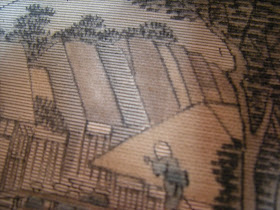
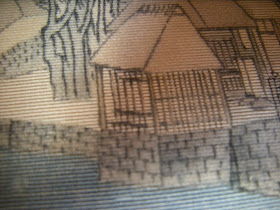
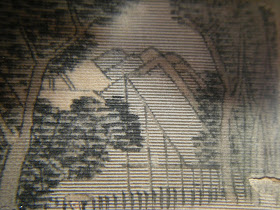
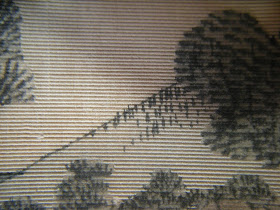
I'm happy to have it in my collection as a piece of wall art, and after framing it with a matte, the little torn off bit isn't even visible. Fortunately for me I had no other bidders to compete with, enabling me to snatch it up for a mere $1.
I initially thought it was a Japanese woodblock print by Utagawa Hiroshige of No. 5 in the series The Fifty-Three Stations of the Tokaido (Tokaido gojusantsugi no uchi)., titled Hodogaya -Shinmachi Bridge (Hodogaya -Shinmachi-bashi, 保土ヶ谷 新町橋 ) which was originally published by Takenouchi Magohachi (Hoeido) in 1832/33 , however, comparing this "print" to known originals, I see many differences in the image as well as the calligraphy and seals, so it's definitely a reproduction created from different carved blocks, perhaps as an item sold to tourists. It shows a lot of age, so it appears to be an older reproduction.
I'm used to woodblock prints being on paper, so I'm quite puzzled by the fact that this is printed on some form of linen or fabric, but what's even more puzzling is the fact that the roofs of the houses, the brick walls, the trees, even the people's clothing, all have this velvet like feel to them, and I'm not sure what that's called nor what the process is, etc, so if you know something about this, please comment and let me know.




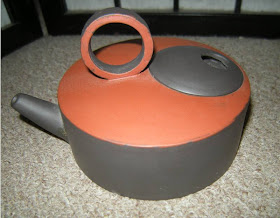
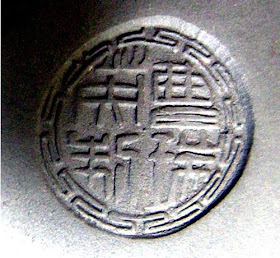
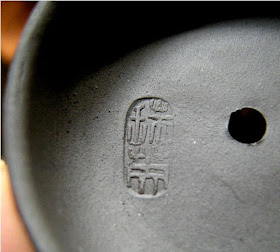
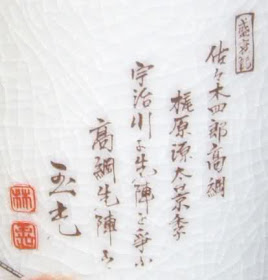
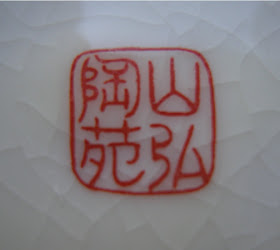

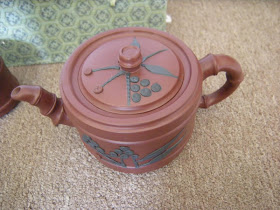

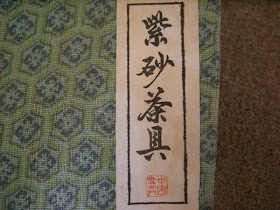
.jpg)
.jpg)
.jpg)
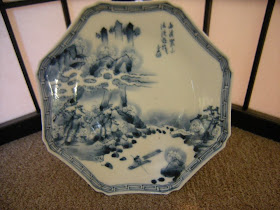
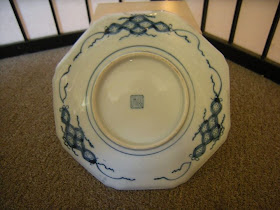
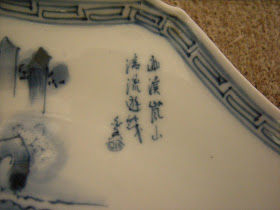

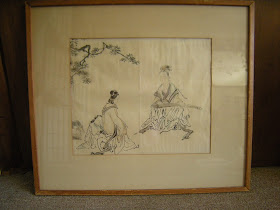
.jpg)
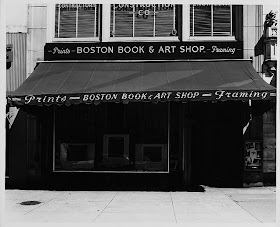
.jpg)

